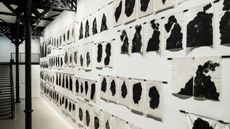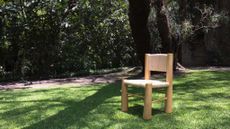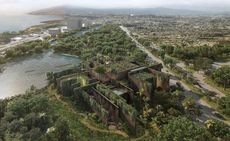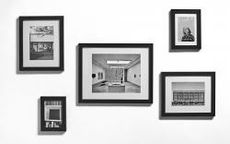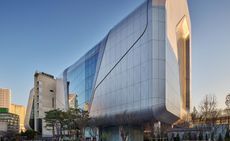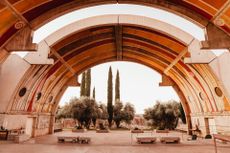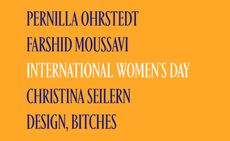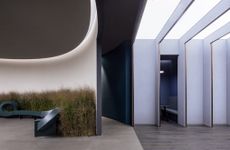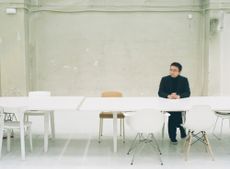The System Lab founder Chanjoong Kim on style and evolution
The Wallpaper* Architects Directory has turned 20. Conceived in 2000 as our index of emerging architectural talent, this annual listing of promising practices, has, over the years, spanned styles and continents; yet always championing the best and most exciting young studios and showcasing inspiring work with an emphasis on the residential realm. To mark the occasion, this summer, we’re looking back at some of our over-500 alumni, to catch up about life and work since their participation and exclusively launch some of their latest completions. South Korean Architects Directory alumnus The System Lab has gone from strength to strength since its 2016 inclusion, with work expanding from private homes to masterplanning, housing and impressive commercial work. Here, we speak to founder Chanjoong Kim to explore the studio's evolution and latest work.
- (opens in new tab)
- (opens in new tab)
- (opens in new tab)
- Sign up to our newsletter Newsletter
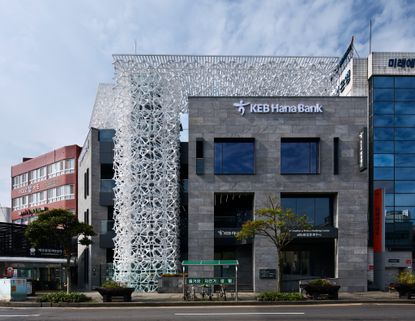
Now one of South Korea's most prominent contemporary architecture practices, The System Lab was founded in Seoul by Chanjoong Kim, a mere eight years ago. The dynamic and, arguably, still fairly young studio quickly made a mark through its eye-catching creations that started off from private housing and smaller scale retail interiors, and quickly evolved to today's growing portfolio that encompasses prestigious commissions, such as a series of office buildings for Hana Banks and larger scale commercial work. We caught up with Kim to discuss the studio's approach to architecture, how it developed since its inception in 2012, and its recent completions, such as Garo Alleys, a shopping destination in the country's capital.
W*: Who is The System Lab? What does your studio stand for?
CK: We believe that a particular language or a style shouldn't be the focus of our work, as architects. Instead, each project should have a system of its own. We strive to find ‘the system' which optimises the conditions of each project. We see ourselves as a laboratory that finds that system, which is how we named our studio. Innovation is the most important value in what we do. Whether it is about coming up with the best construction cost or designing a tiny door knob, innovation should always be present in our projects.
W*: You were featured in the Wallpaper* Architects Directory in 2016 as an emerging firm. How has your practice changed since then?
CK: We have been most interested in improving how we work. In order to do innovative work, the way we work should also be innovative. Our staff number has been growing (we are over 50 people now), but I don't feel that it should mean the size of the office must grow. We try to free people from the physical office. We have been hot-desking for almost two years now, and every week, 20 per cent of our staff work from home, and people take turns coming in.
Our work is now more task-focused and community-based. The office becomes an access point, not a place where everyone needs to show up. Our new practice nurtures collective intelligence, and people operate under their own responsibility. We might also send our staff to work in a plastics factory or furniture maker's studio for a couple of months. We are considering opening a cafe where creatives, such as carpenters or animators, can come to work alongside us. We believe this way of working creates great synergy.

KEB Hanabank Jeju
W*: What motivates you in your designs?
CK: Understanding the challenges and limitations of each project and trying to find the best way to address them (the system).
W*: One could argue that your work has a distinctive visual style. Would you agree? And if so, where does it stem from?
CK: Yes, that's what people often feel, but a distinctive visual style isn't an objective in itself. Instead, aesthetics are the result of the system we identified as the best fit for each individual project. For instance, for Hana Bank Place One, our client told us they wanted to be totally redefined, and not to look like a bank at all. For Healing Stay Kosmos in Ulleungdo, we needed a visually striking building to tell a story and attract people to this remote island, so I came up with a very unusual design.
W*: Your work appears contemporary, perhaps futuristic even, at first glance. What role does tradition and your country's heritage play in your designs?
CK: If you look at our forms, you might feel that we don't have deep relations with Korea's heritage or tradition. However, I believe how we think and how we communicate reflect the Korean way of thinking. Koreans might look rational, but we are actually quite emotional and sensitive.
W*: What role does context play in your designs?
CK: Considering visible context, such as the adjacent building, the physical conditions of the land we are given [is important]. On top of it, I care about the invisible context. I focus on social relations and the community surrounding the site. Who lives nearby, who passes by every day, what kind of jobs these people have, all these things are important.
W*: What can you tell us about the design and concept of two of your biggest recent works, the designs for Hana Bank in Jeju and Busan?
CK: Both sites in Busan and Jeju are in the old centre of the town, neighbourhoods with high density and no public or green space. Hana Bank wanted to create a fresh image and connect with the community, so they decided to offer rooftop gardens for people to come and rest. So I focused on elevators in the middle of the building to give easy access to impressive rooftop gardens. For Hana Bank Jeju, the perforated structure is used to reflect the image of local rocks, which are formed by volcanoes. Hana Bank Busan features a motif inspired from the Jack and the Beanstalk fairytale. The roads surrounding the building are very narrow, and visuals of green stalks climbing up the building to reach the rooftop garden add wit and fun.
W*: Garo Alleys was another key recent project, please could you tell us more about it?
CK: Garosu-ghil, a popular shopping area for young people, has high density and very narrow alleys with no public space or parks. We wanted to create a relaxing route to a rooftop garden, so we built a ramp surrounding the building like a new alleyway. We also persuaded the client to empty the ground floor completely from retail. It has now become a public space that acts as a shaded meeting place for people. Giving up the ground floor's high rental revenue wasn't an easy decision for the client, but it bears a symbolic meaning for what they are trying to do.
W*: What are you working on at the moment, what's coming up from The System Lab?
CK: We are working on a series of collective housing (co-living) projects targeting young professionals for SK D&D, a large Korean developer. For this housing concept, we developed a large trunk, which is easy to assemble and move. If you want to try out living in different neighbourhoods in Seoul, you can pack your belongings in your trunk in the morning, and it will be delivered to your new home when you come back from work in the evening. Each floor has a communal floating balcony lounge. I'm also working on a few resorts and hotels, including a Hyatt in Jeju. And I just finished designing Gentlemonster's new headquarters in Seoul.

KEB Hanabank Jeju rooftop

KEB Hanabank Jeju outside space

KEB Hanabank Jeju offices

KEB Hanabank Jeju meeting room

KEB Hanabank Busan

KEB Hanabank Pusan exterior

KEB Hanabank Busan rooftop

KEB Hanabank Busan sculptural facade

Garo Alleys

Garo Alleys entrance

Garo Alleys interior
MORE WALLPAPER* ARCHITECTS DIRECTORY 2020
INFORMATION
thesystemlab.com (opens in new tab)
Ellie Stathaki is the Architecture Editor at Wallpaper*. She trained as an architect at the Aristotle University of Thessaloniki in Greece and studied architectural history at the Bartlett in London. Now an established journalist, she has been a member of the Wallpaper* team since 2006, visiting buildings across the globe and interviewing leading architects such as Tadao Ando and Rem Koolhaas. Ellie has also taken part in judging panels, moderated events, curated shows and contributed in books, such as The Contemporary House (Thames & Hudson, 2018) and Glenn Sestig Architecture Diary (2020).
-
 34th São Paulo Bienal arrives at Luma Arles for first European presentation
34th São Paulo Bienal arrives at Luma Arles for first European presentationAn exhibition of highlights from the 34th São Paulo Bienal is at Luma Arles, marking its European and tour finale
By Martha Elliott • Published
-
 This winter’s most stylish skiwear, Gucci to Hermès
This winter’s most stylish skiwear, Gucci to HermèsStatement-making skiwear for on and off the slopes, from Louis Vuitton, Dior, Moncler and more
By Jack Moss • Published
-
 Clásicos Mexicanos celebrates Mexican design’s golden age
Clásicos Mexicanos celebrates Mexican design’s golden ageDesign Miami 2022: the Maestro Dobel Artpothecary in collaboration with Clásicos Mexicanos features works from Mexican architect Ricardo Legorreta’s ‘Vallarta’ collection
By Sujata Burman • Published
-
 Out of office: coffee and creative small talk with Tatiana Bilbao
Out of office: coffee and creative small talk with Tatiana BilbaoBodil Blain, Wallpaper* columnist and founder of Cru Kafé, shares coffee and creative small talk with leading figures from the worlds of art, architecture, design, and fashion. This week, it’s Mexican architect Tatiana Bilbao, who is currently designing a brutalist, ethical aquarium in Mazatlán and has an exhibition at Copenhagen's Louisiana Museum of Modern Art opening in October 2019
By Bodil Blain • Last updated
-
 At home with Deborah Berke
At home with Deborah BerkeArchitect Deborah Berke talks to us about art, collaboration, climate change and the future, from the living room of her Long Island home
By Ellie Stathaki • Last updated
-
 Rheaply redefines circular economy in architecture
Rheaply redefines circular economy in architectureOn Earth Day 2022, we speak to Rheaply founder Garry Cooper Jr about his innovative business that tackles reuse and upcycling in architecture and construction
By Ellie Stathaki • Last updated
-
 K-Pop hit factory gets a futuristic new office in Seoul
K-Pop hit factory gets a futuristic new office in SeoulUNStudio completes headquarters building for leaders in K-Pop scene YG Entertainment, in Seoul
By Ellie Stathaki • Last updated
-
 Paolo Soleri's sustainable urban experiment Arcosanti enters new era
Paolo Soleri's sustainable urban experiment Arcosanti enters new eraWe meet Liz Martin-Malikian, Arcosanti’s new CEO, who takes us through the vision and future for Paolo Soleri's sustainable urban experiment
By Hilary Stunda • Last updated
-
 International Women’s Day: leading female architects in their own words
International Women’s Day: leading female architects in their own wordsInternational Women’s Day 2022 and Women’s History Month: Wallpaper* talks to four leading female architects about dreams, heroines and navigating the architecture world
By Harriet Thorpe • Last updated
-
 Brighten Hannam brings luxury living to Seoul’s trendy Hannam-dong district
Brighten Hannam brings luxury living to Seoul’s trendy Hannam-dong districtBrighten Hannam by South Korean developer Shinyoung, architects Urban Agency and architecture studio Intg is Seoul’s latest luxury residential offering in the trendy Hannam-dong district
By Ellie Stathaki • Last updated
-
 Sou Fujimoto judges Wallpaper* Design Awards 2022
Sou Fujimoto judges Wallpaper* Design Awards 2022We chat with Wallpaper* Design Awards 2022 judge Sou Fujimoto about his work in Japan and abroad, and our shortlisted designs and winners
By Jens Jensen • Last updated
